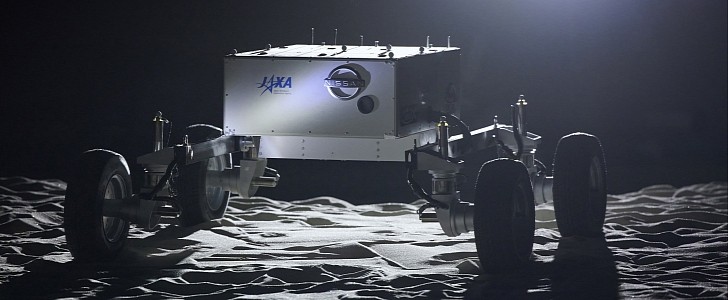Several automakers have already expressed their interest in exploring the Moon. Some have taken this idea to the next level, and they are now joined by Nissan. The car firm based in the Land of the Rising Sun has teamed up with the Japan Aerospace Exploration Agency (JAXA) to make a new lunar vehicle.
Described as a prototype rather than a study, it’s the fruit of the relationship of the two companies, which have been working on rovers since January 2020. Nissan is in charge of the driving controllability and has applied its EV know-how, with the motor control technology found in cars such as the LEAF, and the e-4ORCE AWD system featured in the Ariya zero-emission crossover, to the rover.
In order to be efficient in exploring Earth’s only natural satellite, a rover needs to be able to cope with powdery, rocky, and undulating terrain. It also has to be energy efficient, and this is where Nissan steps in. The company has improved its e-4ORCE technology, developing driving-force controls that minimize the amount of wheel spin, thus improving its traction in arduous conditions.
“JAXA aims to apply the research results to future space exploration. We are collaborating with companies, universities, and research institutes on projects that are feasible and have potential for commercialization and innovation,” said Ikkoh Funaki, JAXA’s Director of the Space Exploration Innovation Hub Center. “By conducting research with Nissan, which has expertise in electrified technologies, we hope to apply our findings to the development of higher-performance lunar rovers.”
While the pictured vehicle remains in a lab for further development, those interested in the e-4ORCE technology will have to wait until next fall to take delivery of the Nissan Ariya in the U.S., if they have ordered the range-topping model, that is. This one uses two electric motors, fed by an 87 kWh battery, and has a total of 389 hp and 442 lb-ft (599 Nm) of torque available on tap. Pricing for the Ariya Platinum+ e-4ORCE AWD kicks off at $58,950 in the United States, and for the FWD base model, Nissan is asking a minimum of $45,950, excluding destination.
In order to be efficient in exploring Earth’s only natural satellite, a rover needs to be able to cope with powdery, rocky, and undulating terrain. It also has to be energy efficient, and this is where Nissan steps in. The company has improved its e-4ORCE technology, developing driving-force controls that minimize the amount of wheel spin, thus improving its traction in arduous conditions.
“JAXA aims to apply the research results to future space exploration. We are collaborating with companies, universities, and research institutes on projects that are feasible and have potential for commercialization and innovation,” said Ikkoh Funaki, JAXA’s Director of the Space Exploration Innovation Hub Center. “By conducting research with Nissan, which has expertise in electrified technologies, we hope to apply our findings to the development of higher-performance lunar rovers.”
While the pictured vehicle remains in a lab for further development, those interested in the e-4ORCE technology will have to wait until next fall to take delivery of the Nissan Ariya in the U.S., if they have ordered the range-topping model, that is. This one uses two electric motors, fed by an 87 kWh battery, and has a total of 389 hp and 442 lb-ft (599 Nm) of torque available on tap. Pricing for the Ariya Platinum+ e-4ORCE AWD kicks off at $58,950 in the United States, and for the FWD base model, Nissan is asking a minimum of $45,950, excluding destination.





























